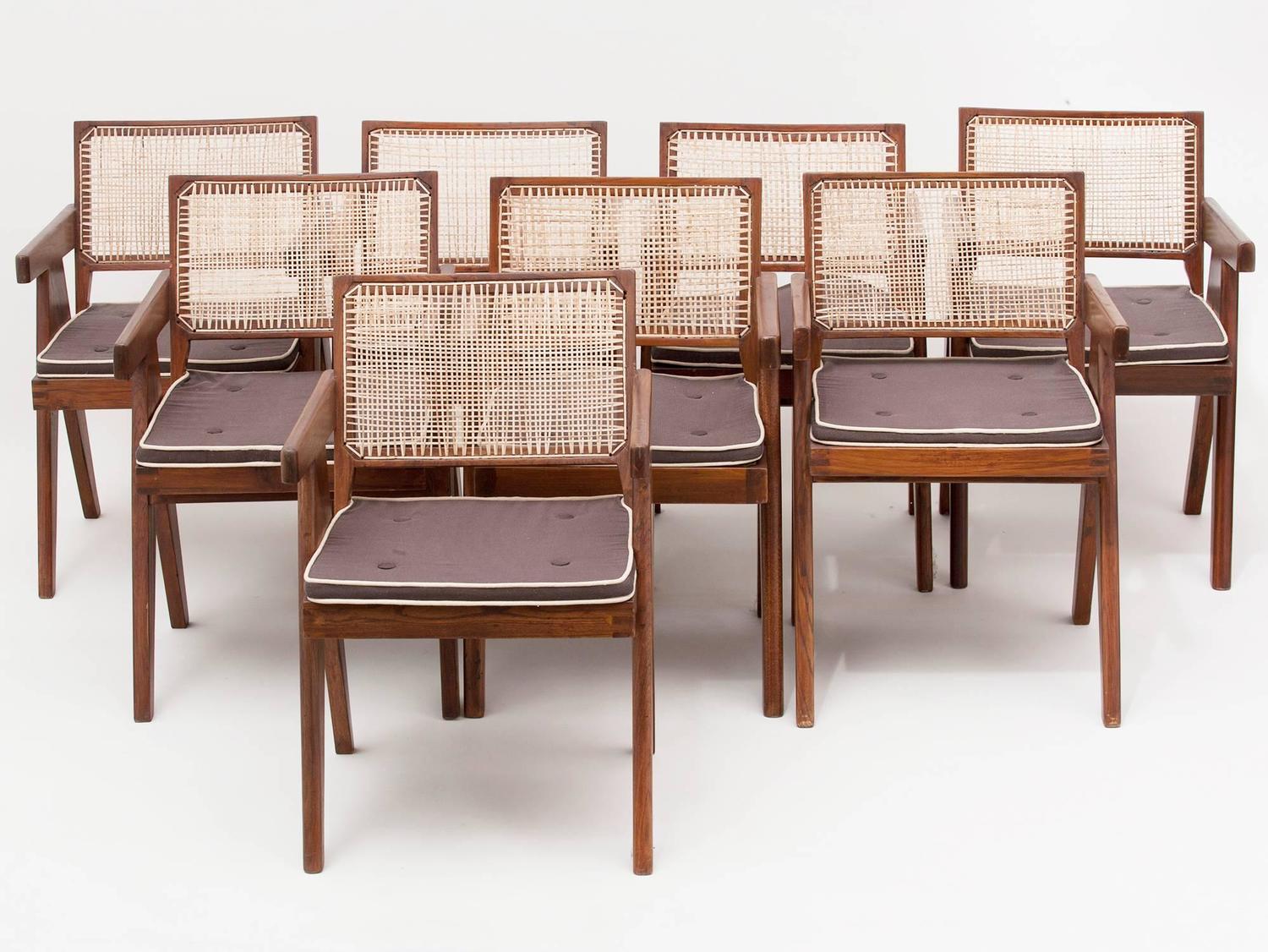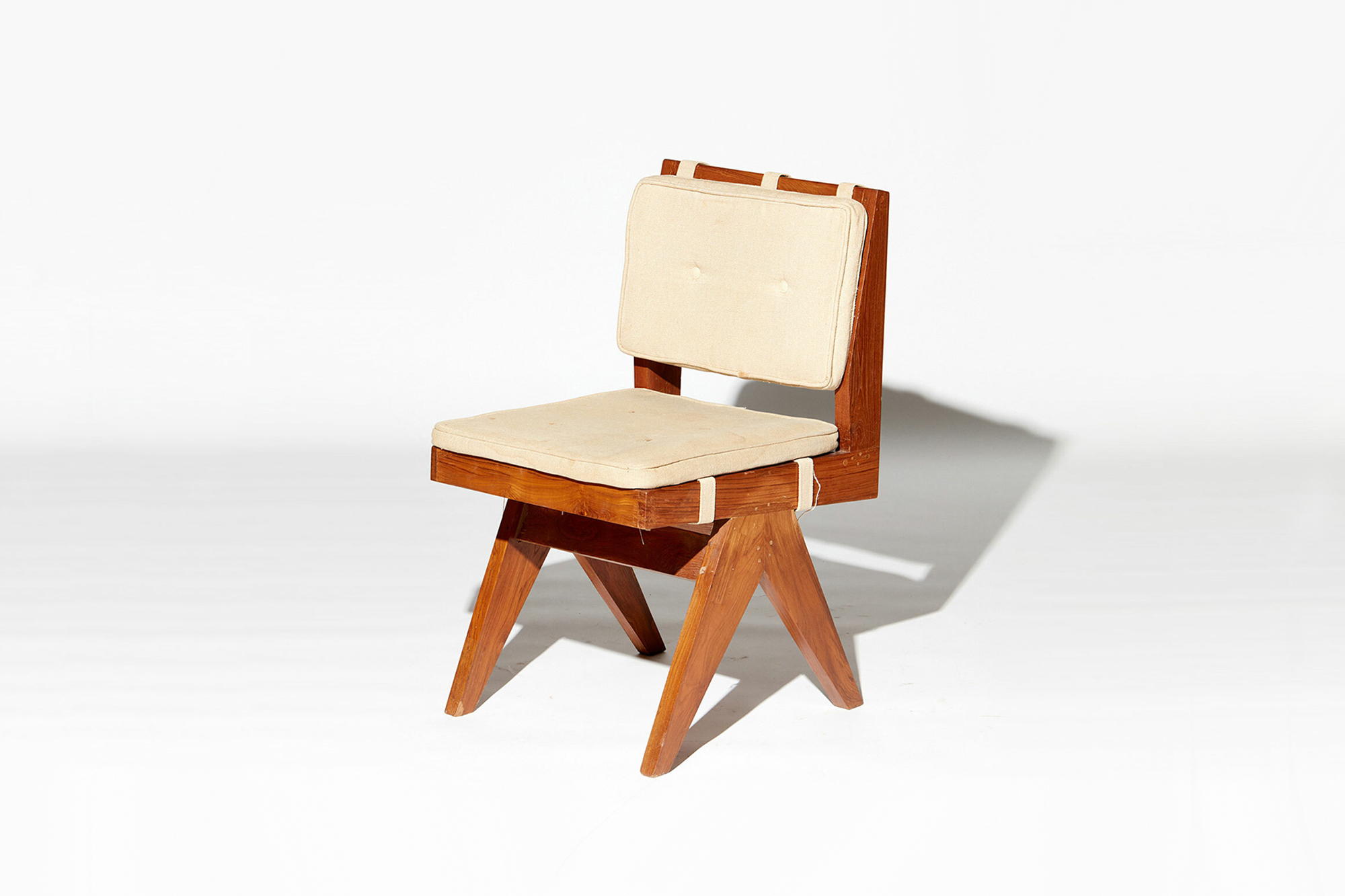Design & Aesthetics of the Pierre Jeanneret Dining Chair

The Pierre Jeanneret dining chair, a testament to mid-century modern design, captivates with its simple elegance and inherent functionality. Its enduring appeal stems from a masterful blend of form and function, reflecting Jeanneret’s commitment to creating accessible yet sophisticated furniture. This chair transcends mere seating; it’s a statement piece, a conversation starter, and a comfortable companion.
Characteristic Design Elements and Variations
The Pierre Jeanneret dining chair is readily identifiable by its distinctive features. The most striking element is its gently curved backrest, often described as subtly embracing the sitter. This curve, combined with the slightly angled seat, provides exceptional comfort. Variations exist, primarily in the armrests; some versions incorporate simple, subtly integrated armrests, while others remain armless, maintaining a clean, minimalist profile. The chair’s legs, typically tapered and slightly splayed, contribute to its stability and visual lightness. The overall silhouette is both refined and robust, a balance achieved through careful proportion and the interplay of lines and curves. Minor variations in the joinery and overall dimensions can also be observed across different production runs and reproductions.
Comparison with Other Mid-Century Modern Designs, Pierre jeanneret dining chair
The Pierre Jeanneret chair occupies a unique position within the mid-century modern landscape. While sharing certain characteristics with other designs of the era, it possesses a distinct personality.
| Feature | Jeanneret Chair | Comparable Chair A (Eero Saarinen Tulip Chair) | Comparable Chair B (Charles & Ray Eames Molded Plywood Chair) |
|---|---|---|---|
| Overall Style | Subtly curved, robust, slightly rustic | Sleek, futuristic, pedestal base | Curved plywood shell, simple base |
| Material | Solid wood (often teak or other hardwoods) | Fiberglass or plastic shell, metal base | Molded plywood, metal or wood base |
| Comfort | Supportive, gently embracing | Modern, somewhat less supportive | Comfortable, adaptable |
| Aesthetic | Warm, natural, slightly informal | Clean, modern, sophisticated | Versatile, adaptable, iconic |
Materials and Their Aesthetic Impact
The Pierre Jeanneret dining chair is typically crafted from solid wood, often teak, though other hardwoods like rosewood or sheesham might be used. The choice of wood significantly influences the chair’s aesthetic. Teak, with its rich golden-brown tones and inherent durability, lends a warm, natural feel. The grain of the wood is often visible, adding texture and visual interest. The natural variations in wood color and grain contribute to the chair’s unique character; no two chairs are exactly alike. The use of solid wood contributes to the chair’s perceived quality and longevity, reinforcing its status as a heirloom piece.
Visual Impact in Different Settings
The Pierre Jeanneret dining chair’s adaptability is remarkable. In a modern setting, its clean lines and organic curves complement minimalist aesthetics, providing a touch of warmth and character. Within a traditional interior, the chair’s natural materials and craftsmanship integrate seamlessly, adding a layer of sophistication without disrupting the overall style. In a minimalist space, the chair’s unadorned elegance becomes a focal point, its simple form drawing attention to its inherent beauty. Its versatility allows it to function as a standalone statement piece or as part of a larger ensemble, effortlessly blending into diverse environments.
Historical Context and Production

The Pierre Jeanneret dining chair, a seemingly simple yet powerfully evocative piece of furniture, is inextricably linked to the ambitious and utopian vision of Chandigarh, India’s planned city. Its creation and subsequent production history offer a fascinating glimpse into mid-20th-century design, post-colonial architecture, and the enduring appeal of modernist aesthetics. The chair’s story is one of both grand design and intricate, sometimes chaotic, manufacturing processes.
The chair’s design emerged directly from the collaborative efforts of Le Corbusier and his cousin, Pierre Jeanneret, during their work on the master plan for Chandigarh, beginning in the early 1950s. Commissioned by the newly independent Indian government, the project aimed to create a model city embodying the principles of modernism and functionality. Jeanneret, overseeing the furniture design for the administrative buildings and government offices, created a range of pieces, including this iconic dining chair, that perfectly reflected the project’s ethos. The chair’s design is characterized by its simplicity, its use of locally sourced materials, and its adaptability to various settings within the city. It embodies the spirit of functionalism, prioritizing practicality and durability over ostentatious decoration.
Chandigarh’s Influence on Chair Production
The chair’s production is intrinsically tied to the construction of Chandigarh itself. Initially, the chairs were manufactured locally in workshops set up specifically for the city’s development. This meant that the production was directly overseen by Jeanneret, allowing for a degree of control over the quality and craftsmanship. The use of local materials, like teak wood, further emphasizes the chair’s connection to its place of origin and the ethos of the city’s development. The workshops employed local artisans, fostering a unique blend of traditional craftsmanship and modernist design principles. This early phase of production reflects a collaborative spirit, combining the vision of the architects with the skills of local craftspeople.
Timeline of Production
The following timeline Artikels key milestones in the chair’s production:
- Early 1950s: Initial design and production of the chair for government buildings and offices in Chandigarh.
- 1950s-1960s: Continued production in Chandigarh workshops, supplying furniture for various governmental and public buildings.
- 1960s-late 20th century: Production largely ceases as the initial need for furniture in Chandigarh is fulfilled. The chairs remain in use within the city.
- Late 20th and early 21st century: Rediscovery of the chair’s design and its increasing popularity amongst design enthusiasts and collectors. This leads to renewed interest in its production.
- Present Day: Several manufacturers produce reproductions of the chair, though variations in materials and craftsmanship exist. The original chairs remain highly sought-after collector’s items.
Evolution of Design and Manufacturing Variations
While the fundamental design of the Pierre Jeanneret chair has remained largely consistent, subtle variations exist across different production periods and manufacturers. Early chairs, produced in Chandigarh workshops, often exhibit slight differences in joinery techniques and wood grain, reflecting the handcrafted nature of their production. These early chairs are generally considered to be of superior quality and craftsmanship, commanding higher prices in the secondary market. Later reproductions, while aiming for authenticity, may employ slightly different materials or manufacturing processes, resulting in variations in overall aesthetic and durability. The differences in the finish, the subtle variations in the dimensions, and even the type of wood used can all contribute to the unique character of each chair. Some manufacturers might prioritize mass production techniques, potentially compromising on the level of detail found in the original Chandigarh-produced chairs. The variations highlight the complex interplay between design intent, manufacturing capabilities, and market demands.
Market Value and Collecting: Pierre Jeanneret Dining Chair

The allure of a Pierre Jeanneret dining chair extends beyond its aesthetic appeal; it resides in its historical significance and the consequent market value. Several factors intricately intertwine to determine the price a collector will pay, making each chair a unique investment. Understanding these factors is crucial for both buyers and sellers navigating this specialized market.
Pierre jeanneret dining chair – Condition, provenance, and rarity are the cornerstones of a Pierre Jeanneret chair’s value. A chair in pristine condition, meticulously preserved and showing minimal wear, commands a significantly higher price than one with damage or extensive restoration. Provenance, or the documented history of ownership, adds substantial value, particularly if the chain of ownership can be traced back to its original use in Chandigarh. Rarity, often tied to specific designs or limited production runs, also contributes to a chair’s desirability and price. Chairs with unique features or those associated with specific projects within Chandigarh’s architectural legacy are highly sought after.
Price Comparison: Authentic vs. Reproduction Chairs
The following table illustrates the significant price difference between authentic Pierre Jeanneret chairs and their reproductions. Note that these ranges are estimates and can vary depending on the specific chair, its condition, and the market conditions at the time of sale.
| Factor | Authentic Chair Price Range | Reproduction Chair Price Range | Notes |
|---|---|---|---|
| Condition (Excellent) | $10,000 – $50,000+ | $500 – $2,000 | Price increases exponentially with better condition and provenance. |
| Condition (Good, minor wear) | $5,000 – $25,000 | $300 – $1,500 | Minor repairs can affect value, even in reproductions. |
| Provenance (Documented History) | Adds significant value to the price range above | Minimal impact on price | A verifiable history substantially increases the value of an authentic chair. |
| Rarity (Unique Design) | Can significantly increase the price range above | Replications often lack unique design features. | Extremely rare chairs can fetch prices exceeding the listed ranges. |
Authenticating Pierre Jeanneret Dining Chairs
Discerning authentic Pierre Jeanneret chairs from reproductions requires careful examination and a keen eye for detail. Potential buyers should seek expert opinions from reputable dealers or auction houses specializing in 20th-century design. Key features to scrutinize include the chair’s construction, materials, and joinery techniques. Authentic chairs typically exhibit superior craftsmanship, using high-quality materials and precise joinery. Documentation, such as original sales records or provenance research, is invaluable in verifying authenticity. Comparing the chair to known examples in museums or reputable online resources can also assist in authentication. Be wary of overly low prices, as these often indicate reproductions.
Rewritten Article on Pierre Jeanneret Dining Chairs
[Insert rewritten article text here. This section requires the original article text to be provided for rewriting. The rewritten version will be free of language suggesting AI assistance and will maintain a factual and engaging tone.]
